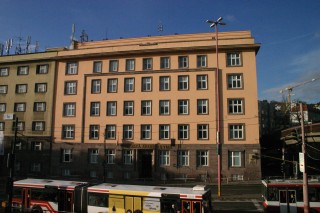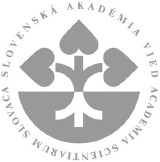Slovak Academy of Sciences (SAS), Bratislava

Category:
- Cultural research

 The Slovak Academy of Sciences (SAS) is an autonomous scientific institution of the Slovak Republic with a nationwide scope, whose activities are focused on the development of science, educational level, culture and economy. It is aimed at basic research in selected fields of natural, technical and social sciences and it applies new scientific knowledge in applied research, in economic and social spheres, and in expert, consulting, scientific, cultural and educational activities. Research activities in the Slovak Academy of Sciences are developed in close connection with scientific institutions abroad. The Slovak Academy of Sciences is a part of world science.
The Slovak Academy of Sciences (SAS) is an autonomous scientific institution of the Slovak Republic with a nationwide scope, whose activities are focused on the development of science, educational level, culture and economy. It is aimed at basic research in selected fields of natural, technical and social sciences and it applies new scientific knowledge in applied research, in economic and social spheres, and in expert, consulting, scientific, cultural and educational activities. Research activities in the Slovak Academy of Sciences are developed in close connection with scientific institutions abroad. The Slovak Academy of Sciences is a part of world science.
The history of the Slovak Academy of Sciences may be traced back to the 16th and 17th centuries, when the first modern scientific academies were established with the aim of creating better conditions for science than traditional universities – until then the only scientific institutions. In 1735, in accordance with the ancient Platonic tradition, Matej Bel drew up a proposal to establish the Societas Litteraria in Bratislava, but his project was not carried out. Based on the initiative of patriotic philologists, the Slovak Learned Society (Slovenské Učené Tovaryšstvo) was established in 1792. This was followed in 1844 on the initiative of Ľudovít Štúr by the establishment of Tatrin, a cultural society with a nationwide scope. In 1892 Andrej Kmeť published in the National Newspaper (Národné Noviny) a proposal for the establishment of the Slovak Scientific Society. During the period of the Czechoslovak Republic Šafárik’s Learned Society acquired national importance in the field of science. After the establishment of the first Slovak Republic this Society began to perform its activities under the name Slovak Learned Society. With the resolution of the Slovak Assembly from 2 July 1942 the Slovak Academy of Sciences and Arts (SAVU) was established as a representative and also executive scientific institution. In the post-war period the Slovak Academy of Sciences and Arts was transformed into the Slovak Academy of Sciences, which was officially established by law of the Slovak National Council on 18 June 1953. Since that time the structure of the Slovak Academy of Sciences has changed with the course of time, but the greatest changes occurred in 1989. The Slovak Academy of Sciences transformed into a modern scientific organisation, whose activities and results are comparable with those in developed foreign countries.
The Slovak Academy of Sciences currently performs its activities through 70 scientific specialised and service organisations. One of the priorities of the Slovak Academy of Sciences is the education of researchers and co-operation with universities. The SAS annually issues more than 50 scientific journals that are mostly recorded in international databases, and about 100 monographs. On the basis of bilateral agreements it has nearly 70 co-operation agreements with partner institutions abroad, it is a member of major international scientific organisations and consortia, it co-ordinates the membership of 30 national committees of the Slovak Republic in international scientific organisations, it represents Slovakia in the International Council for Science (ISCU) and its representatives are active in EU institutions, UNESCO, NATO and the OECD. It is one of two Slovak representatives in the ESF (European Science Foundation). SAS staff annually participate in organising a number of international scientific events, the SAS provides scientific services in the field of seismology, geomagnetism, hydrology, archaeology, microbiology, virology and epidemiology, and it operates the National Cancer Register, the European Collection of Yeasts, the National Language Corpus and Encyclopaedic Programme. In recent years the Slovak Academy of Sciences has been involved in various successful EU projects and it has undertaken concentrated cutting-edge research in several major scientific fields, which is performed through the SAS Centres of the Excellence.
The highest self-governing body of the Slovak Academy of Sciences is the SAS Assembly that consists of members elected by academic communities of scientific organisations from the academic community of the SAS. The administrative body of the Slovak Academy of Sciences which addresses scientific and conceptual tasks is the SAS Scientific Council that is made up by members of the SAS Presidium, delegated representatives of universities, delegated representatives of business field of research and development and elected representatives of organisations and departments of research and development outside the SAS. The executive self-governing body is the Presidium of the Slovak Academy of Sciences. The head of the Slovak Academy of Sciences is the President who is appointed and dismissed by the President of the Slovak Republic.
